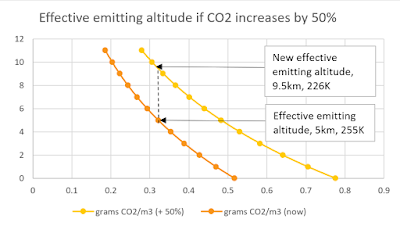From The Motherlode:
This is how the Greenhouse Effect works. The Greenhouse gases such as carbon dioxide and water vapour absorb most of the heat radiation leaving the Earth's surface. Then their concentration determines how much heat escapes from the top of the atmosphere to space. It is the change in what happens at the top of the atmosphere that matters, not what happens down here near the surface.
So how does changing the concentration of a Greenhouse gas change how much heat escapes from the upper atmosphere? As we climb higher in the atmosphere the air gets thinner. There is less of all gases, including the greenhouse gases. Eventually the air becomes thin enough that any heat radiated by the air can escape all the way to Space. How much heat escapes to space from this altitude then depends on how cold the air is at that height. The colder the air, the less heat it radiates.
So if we add more greenhouse gases the air needs to be thinner before heat radiation is able to escape to space. So this can only happen higher in the atmosphere. Where it is colder. So the amount of heat escaping is reduced. By adding greenhouse gases, we force the radiation to space to come from higher, colder air, reducing the flow of radiation to space. And there is still a lot of scope for more greenhouse gases to push 'the action' higher and higher, into colder and colder air, restricting the rate of radiation to space even further.
Let's follow their logic and see where it takes us...
Here's a chart showing approx. current CO2 levels per m3 at altitudes up to 12 km (vertical axis) in orange, and what they would be if they went up by 50% in yellow. The current effective emitting altitude is at about 5km, where the average temperature is about 255K and CO2/m3 just over 3 grams. So assume that if there is less than 3 grams/m3, the atmosphere is no longer opaque to infra red radiation and it can escape to space.
 According to them, the new effective emitting altitude would be wherever CO2/m3 is just over 3 grams/m3, i.e. at about 9.5 km. The average temperature at that altitude is 226 K. If you calculate the amount of W/m2 radiated, it would go down from 239 W/m2 to 148 W/m2, a complete imbalance and not plausible.
According to them, the new effective emitting altitude would be wherever CO2/m3 is just over 3 grams/m3, i.e. at about 9.5 km. The average temperature at that altitude is 226 K. If you calculate the amount of W/m2 radiated, it would go down from 239 W/m2 to 148 W/m2, a complete imbalance and not plausible.
The more sophisticated Alarmists say that the temperature of the new, higher effective emitting layer - and everything beneath it - will increase to whatever it needs to be to emit 239 W/m2 and reinstate the equilibrium between incoming solar and outgoing infra red. Sounds plausible until you realize that would require a temperature increase of nearly 30 degrees all the way up, which is also completely implausible and ten times as much as the most pessimistic predictions, before we treble it for the 'positive feedback of water vapour' (to the extent it exists, which it doesn't). As a matter of fact, CO2 levels have gone up by about 50% since the end of the Little Ice Age pre-industrial levels and temperatures have gone up by 1.5 degrees at most.
If you get nonsense answers, you can safely assume that the logic is nonsense!
